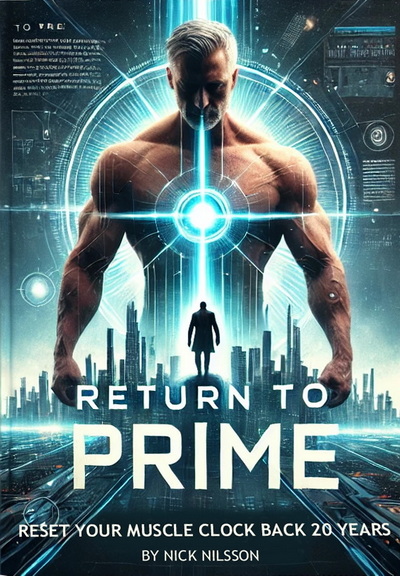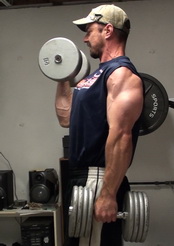This chin-up variation takes the concepts of stable and unstable training and applies them to the same exercise at the same time.
It does require a bit of special equipment in the form of a pair of training bands.
I get my bands from here and HIGHLY recommend this company as a source for them.
The One-Bar One-Band Chin-Up is a very simple concept...instead of gripping onto a pull-up bar with both hands, you're going to be gripping on a bar with one hand and bands with the other (I found I needed two green bands to offset my bodyweight of about 212 lbs).
1. This provides instability on one side (the bands are bouncy). This bounce also "unlocks" the joint, allowing for more pain-free movement in the shoulder joint.
2. It gives you more freedom of movement (you're not locked into any specific movement pattern) during the pull-up. Shoulder issues can be a big problem with bar pull-ups done for high frequency and/or high volume. Bands move freely allowing your shoulder joints to move as they need to.
3. The bands dissipate some of the force that your lats generate to move your body (on one side at least!), making every single rep harder....i.e. every time you apply force to the bands, they stretch. You have to therefore exert MORE force to move the SAME weight.
4. You can use that bounce to "spot" yourself. For example, if you're stuck and stopped at a certain point, you can let up on the band on one side to get into a more favorable leverage position, then give it a quick pull down to "ratchet" yourself up a little further.
How to Do One-Bar One-Band Chin-Ups
To do this one, you'll need a power rack (a Smith machine could potentially work as well), and a pair of bands.
This is the setup that worked best for ME. You might need to play around with the setup, depending on your equipment.
This will take a little bit of messing around with heights, but it's not difficult.
Hitch two bands to the top cross-bar of the rack and set the safety rails at about forehead height. Set a bar on the rails.

Now bring the loose ends of the bands over the other cross bar of the rack.

Grip onto the ends of the bands.

Now grip onto the bar and stretch the bands. Your knees will likely be almost on the ground. This is where you might need to adjust the height of the rails a bit.

Now do a chin-up.
The resistance of the bands should be enough that the bands don't stretch too overly much as you pull yourself up.

I find this method really gets the core involved in stabilizing the body when doing the exercise.
Here's what it looks like directly from the side, with the hands switched around. I recommend resting before switching to the other side.


You'll see in the video above that when I get near the end of the set, I actually let the bands come up then give a sharp pull on the bands to help come the rest of the way to the top...like self-spotting.
This really allows you to push your lats hard. You can maintain tension on the one side while you use the other side to give yourself a little boost...no body movement or kipping required. Just muscle action.
One-Arm Hanging Pulldowns
This exercise is similar to the band version in concept (stability on one arm and instability on the other) but it does require a very specialized equipment setup, specifically a power rack with a high pulley cable attached to it.
You'll rarely ever find something like this in a commercial gym but it's fairly common in home gym racks.
The main difference is that instead of doing a straight chin-up, you're actually going to be doing a one-arm pulldown with your one arm while hanging in place with the other arm.
This results in a very strong lat contraction...I also found it to be INCREDIBLY challenging to the core. It takes a lot for me to get core soreness and this did it.
Here's what it looks like on video...
If you have this type of setup, definitely give this one a try, if you're fairly strong on chins.
Set the J hooks near the top of the rack...around forehead height on my setup. Attach a single handle to the high pulley.
Set the weight on the stack to slightly less than half your bodyweight. I weigh 212 lbs here and I found 100 lbs on the stack to be just about right.
Grip the bar in the center then grab the handle. Pull yourself up until your "bar arm" is about halfway bent. We want this to be in a strong position for an isometric hold.

Now do a pulldown with the other arm. It's going to be a fairly short range of motion, unless you have a very tall rack and pulley. Still very effective, though.

This contraction will light up your lats and the deep muscles of your core. These muscles are active just supporting the lower body in the chin-up position...now we add cross tension.
Here's a different view. This shows you the bend in the non-moving arm.


This combination of a stable and unstable exercise is also combined with an isometric and isotonic (moving) movement.
It's a very unique and challenging training stimulus...and if you have the equipment, it is fast and easy to set up.
---
Are you 40...50...60 or even 70+ years old and want to build muscle and strength like you did 20 years ago?
If you feel like you're fighting a losing battle, you're ready to discover the REAL secret to REVERSING muscle loss due to aging...
*** You need to train the body systems that SUPPORT your muscle mass, not just the muscle itself. ***
These underlying support systems diminish as you age, which is why you lose muscle as you get older no matter how hard you train... but with strategic training, these systems can be regenerated.
Share This Page...
Want More Exercises Like This?
You'll find them here...



